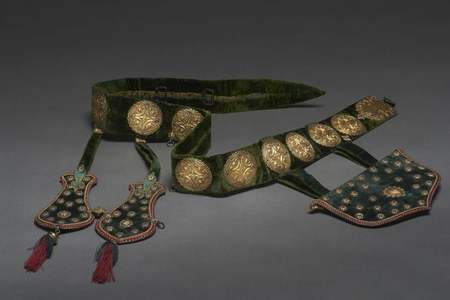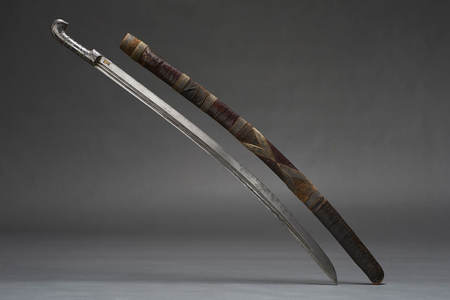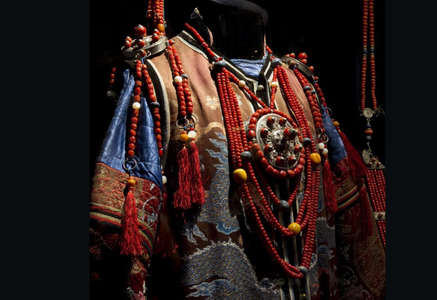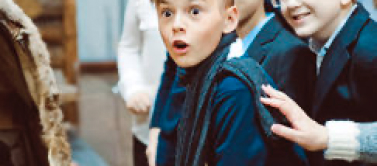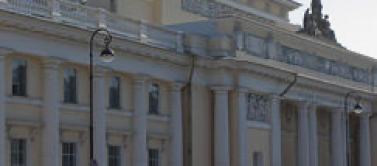Rarities Department

The Rarities Department includes assets combined by the principles of storage of various types of materials or theme groups of objects. Currently, the department contains about 40,000 items. The Rarities Department includes assets combined by the principles of storage of various types of materials or theme groups of objects (storage conditions, security needed, dimensions etc.). Represented in the department’s collections are all regions and peoples of the Russian Empire – USSR – current Russia and neighboring states. Some subdivisions of the department have actually existed since the Museum establishment date – such are the Special Storeroom and the Archive, others were detached from regional departments in the 1930–1950s.
Special Storeroom: Depository where various objects of traditional culture containing precious metals and stones are kept. The asset traces back to the time of the Museum building’s design, in which it was planned from the outset to outfit a space (with armored doors provided with safe locks, and shutters) for especially valuable objects. The “armored storeroom” received objects from the day of the Museum building’s putting into operation; its first curator was the Museum’s record clerk V. L. Albrecht. In the early 1930s, the depository’s name was changed to “Valuable Storeroom.” Later there were more changes, new instructions were issued, the rules were refined, but the depository continued to operate as the Museum’s especially valuable asset. Today’s meaning of the Special Storeroom (and its new name) was given in 1949, when the first nation-wide instruction for accounting and storage of objects containing precious metals and stones. The current accounting system adopted on the basis of this instruction in 1949–1952, as amended and improved, remains valid up to this day. In 2005–2007, the depository was repaired and provided with new equipment.
Among the depository’s items are offerings to the Russian Imperial Family from representatives of various peoples. Some of them are displayed in the Storeroom’s part opened for visitors, for instance gifts from Buddhists of East Siberia, Dalai-lama XIII, and peoples of the Caucasus and Central Asia.
The earliest artifacts of the Museum are dated 16th – 17th centuries. These are Russian silver buttons, earrings, and a small enameled box. The storeroom has about fifteen hundred objects of the 18th century. But the bulk of the items are dated the 19th and 1st half of the 20th century, and some of them are really unique. For instance, a ritual beer chalice (Gamistevis tasi) used during celebrations in a Khevsurian sanctuary, or medal of the Order of Shamil, or decoration for kerchief fastening, in whose pendants are three rarest Georgian coins of the last quarter of the 18th century, related to so-called “Bagratuni silver.” The depository has rare specimens of richly decorated traditional weapons, saddles, and harness components. A large collection of pearl-embroidered Russian headgear is presented. Decorations, clothes, spiritual culture objects, and utensils of various peoples of Russia and neighboring countries are also kept there.
Weapon storeroom: Depository keeping a collection of weapons of various Eurasian peoples and several weaponry items from other regions. The depository was detached from the Museum’s other depositories in the 1950s during the after-war inventory of items. In 2005, the Weapon Storeroom moved to a new space outfitted in accordance with today’s standards.
Among the earliest weapon specimens are a sword and a saber blade of the 14th and 15th century. The depository has several 17th century poleaxes. However, the most widely presented is the period of the late 18th – early 20th century. This part of the collection is interesting in that it presents everyday life objects collected amidst the live folk culture in the late 19th – 1st half of the 20th century.
Most of the weapons kept in the firearms depository were used for hunting or played a representative role as a symbol of manhood and noble birth. The Russian painted flint guns of the 19th century will claim your attention. Siberian hunting specimens are interesting. In the foreign peoples collection, focus on a rather rare Japanese matchlock gun of the Edo period with the Tokugawa clan blazons. Along with these, the collection has items manufactured by well-known firearms factories of Europe and America, which the Russians used mostly for hunting.
Musical storeroom: Depository keeping musical instruments forming part of the traditional spiritual culture of various peoples, including both professional and plain folk musical instruments. The acquisitions for this depository started in 1936 when a folklore music section was set up in the Museum, to which musical instruments from the Museum’s regional depositories were handed over, and ended in 1939 when the Musical Storeroom was established.
The collection’s basis is the expedition acquisitions of the Museum’s personnel, complementing the collections of well-known researchers, founders of Russian ethnic instrument science S. G. Rybakov, N. I. Privalov and others.
The Museum’s collection of sound tools / musical instruments covers the period from the early 18th century to our days. The earliest samples include the Georgian war trumpet gorototo, Belarusian gusli, Ingrian kantele, and Tlingit tambourine.
Some types of instruments presented in the collection fell out of active use as early as at the break of the 20th century; among them are a unique Abkhaz harp and Besermyan bagpipe. The rare specimens include musical instruments of small indigenous minorities of the Caucasus, Siberia, and Far East, and of currently non-existent local ethnic groups such as Estonian Swedes.
Carpet depository: Depository keeping carpets and carpet products characterizing the carpet making traditions of various peoples, among which are lots of rarest articles of a highest artistic level. The storeroom was detached from the Museum’s regional funds in the 1950s, during the post-war inventory.
The start to building the Museum’s carpet collection was given by S. M. Dudin’s first expedition delivery in 1901. Later, gifts from Nicholas II came in, and many items were purchased from S. S. Solomko and A. V. Vereschagin.
The largest part of the collection is Caucasian, Central Asian, and Ukrainian carpets. The collection of Turkoman carpet products stands out with its exceptional diversity; it presents carpets typical for different local groups of the Turkomans.
The oldest Museum exhibits in the collection are dated 2nd half of the 18th century. They are the Turkoman carpets and Ukrainian kilims purchased in an expedition in the early 20th century, and one Azerbaijani carpet.
The unique collection of ten Finnish carpets of the late 18th – 1st half of the 19th century was brought to the Museum by U. T. Sirelius. Of great interest are Tyumen long-pile sledge and chest-covering carpets. The depository also covers cooperative carpet making of the Soviet period, in particular in regions where carpet making did not exist before.
Felt storeroom: Depository keeping felts and felt articles, in particular yurts and tents. Collecting felts is very important, since these simple objects intended for use in everyday life are much worse preserved in culture, therefore they are not so widely presented in museum collections.
The depository mostly contains Caucasian and Central Asian felts. It has full sets of side felts for yurts, and felts for a yurt’s roof and door.
Among the very rare items are a Nogai wedding flag and prayer rug.
Fur storeroom: Depository keeping most diversified exhibits made of peltry or trimmed with fur, in particular clothes of various peoples, household items and utensils, skis, covers, saddles, and animal pelts.
Curiously, the very first object acquired by the Museum (under No. 1–1) is kept in the Fur Storeroom of all places; it is an Evenki outer garment.
Presented in the depository are objects typical for different peoples. It has many Siberian and Russian objects.
One of the most valuable and unique exhibits of the depository is the horse skin with the skull, hoofs, and remnants of limbs from the place of the Altai ritual taelga acquired for the Museum by S. I. Rudenko.
A very valuable item of the depository is a chekman fur coat of the Yazid Kurds of Yerevan Province. It was made fur inside, covered with gold-embroidered red cloth on the outside, and with a green lining inside. Such garments were signs of status, which is indicated by the red upperside and green underside.
Storeroom of means of transport and agricultural tools: Depository keeping large-size objects for various purposes, such as boats, sleds, dog sledges, dray-carts, harrows, plows etc. It is the smallest depository by the number of museum objects and the largest by its area, and not by accident. The depository keeps the largest objects like arbas or boats. For instance, two Uzbek arbas have a wheel diameter above human height. They were a kind of off-roaders of that time.
The oldest, and at once the heaviest exhibit of this depository is a stele of the South Siberian Okunevo archeological cattle herding culture of the Bronze Age (late 3rd – early 2nd millennium BC).
The Illustrations Depository keeps sketches, watercolors, prints, paintings, specimens of open-work paper ornaments, clothing patterns, drawings, and postcards. Of special scientific value are sketches made by artists during ethnographic expeditions specially for the museum collection. The depository’s building began simultaneous with the Museum’s object collection in the early 20th century, but was not detached into a specialized storage unit until the 1950s. In 2013-2015, the depository was completely repaired and refitted.
The Rare Book Depository was detached from the Museum’s scientific library in 2011.
The depository includes early printed books before the 18th century, Cyrillic script books of the 18th and 19th century, Russian and foreign publications before 1850, and albums and other illustrated editions (periodicals included) that are of historical and artistic interest.
Currently, the depository has over 1,200 printed and manuscript books and periodical and illustrative editions in Russian and in foreign languages. They are descriptions of embassies and travels; scientific treatises; publications on numismatics, history, geography, ethnography, religion; albums of lithographs; magazines.
The timescale of the editions is between the mid-16th and early 20th century.
The earliest book in the collection is the opus by German Humanist Johann Boemus “Morals, Laws, and Customs of All Nations” released in Venice in 1542 (Boemus, Iohann. Omnium Gentium mores, leges et ritus, ex multis clarissi misrerum scriptoribus … Venetiis, … M D XXXXII).
Among the Russian publications of the 18th century, of special interest are the works of researchers and travelers – N. P. Rychkov (participant of P. S. Pallas’s 1769–1770 expedition) and I. I. Lepyokhin, researchers of steppe regions of the Russian Empire. The collection contains three volumes of “Diurnal Notes of the Travel of Captain Nikolai Rychkov in Various Provinces of the Russian State in 1769 and 1771” illustrated with engraved geographic maps; and “Journey of Academician Ivan Lepyokhin” with tables and sketches of fauna.
In the depository you may see the unique opus of disputable authorship “Collection of Russian folk songs with their voices …”. Our Museum keeps the 2nd edition of that opus (St. Petersburg, 1806) collected by N. A. Lvov but published under the name of I. Pratsch who wrote down the scores of the book’s songs. Ivan Pratsch scored for piano the music of “The Miserable Paladin Kosometovich,” a comical opera by Catherine II, whose word book is also kept in the depository. (Catherine II. “The Tale of the Miserable Paladin Kosometovich and a Comic Opera on the Words of the Tale.” In St. Petersburg… 1789.)
The 2nd half of the 19th and early 20th century was the time of advent of large-size, richly illustrated albums and sheet editions made by chromatic printing (chromo lithography). One of such publications of a great historic and artistic value is “Antiquities of the Russian State,” an opus in many volumes created over many years by artist F. G. Solntsev, who in his travels to old Russian towns from 1830 carefully sketched all ancient things of historic value. The edition consists of five hundred chromo lithographs in six albums, with explanatory text in separate fascicles. In these albums, one may see the silk caftan of Tsar Ivan Vasilievich, silver grace cup of Grand Duke Ioann III, facades of the wooden palace in Kolomenskoye, and mitre of Patriarch Nikon.
An interesting example of an illustrated edition may be the album “The Old Clay Toys of Vyatka” created by artist Alexei Denshin in 1926. Due to his selfless activity, the Dymkovo clay toy handicraft has been preserved and continued. The album’s text is printed in a printing office, the drawings are colored with the author’s own hand, the photos are supported with social and historical overviews.
Currently, the books are stored in accordance with the conditions necessary for their accounting, they are restored, studied, provided to researchers for work in the depository’s reading room, and actively used in the Museum’s exhibitions.

